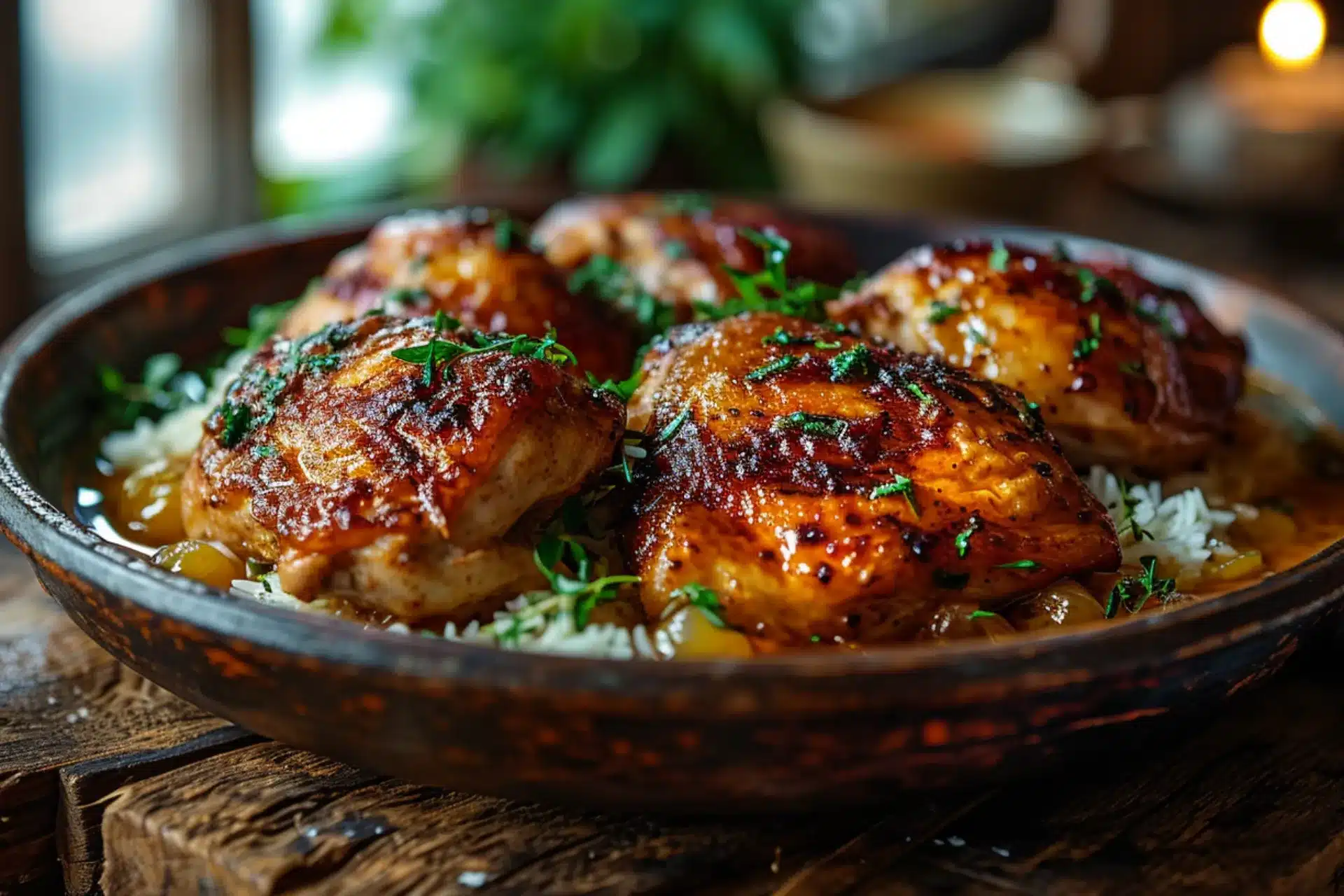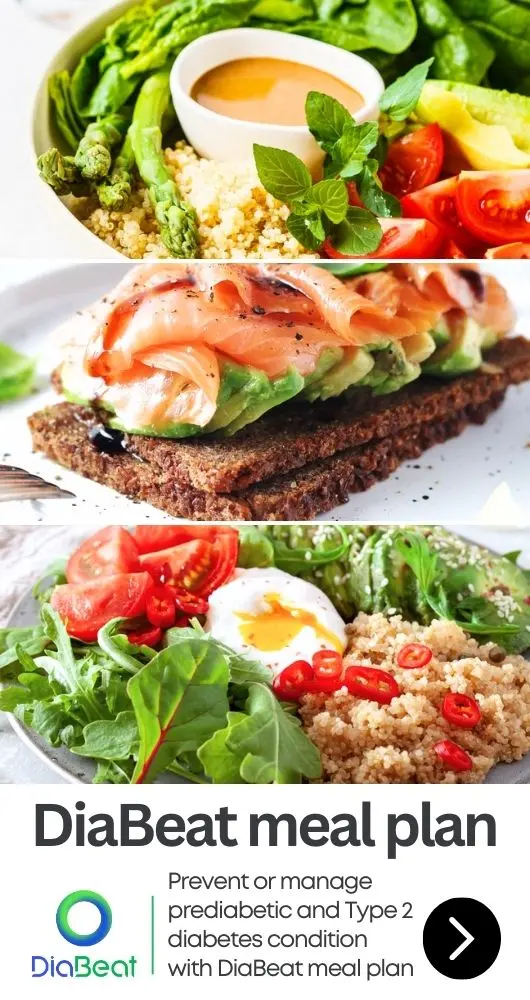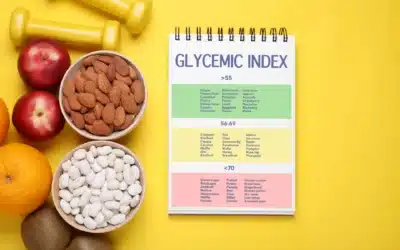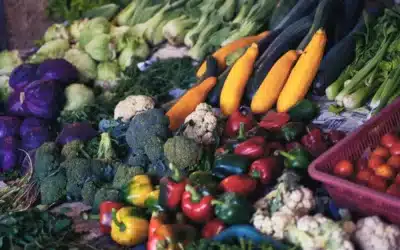Introduction to “Baked Chicken and Wild Rice with Onion and Tarragon”
Navigating a diabetic diet can be both challenging and rewarding, especially when it comes to creating meals that are both nutritious and delicious. Baked chicken and wild rice with onion and tarragon is a dish that perfectly encapsulates this balance. Rich in flavors and packed with health benefits, this recipe is designed to align with the dietary needs of individuals managing diabetes. In this article, we will explore the nutritional value of each ingredient, providing a detailed guide to preparing this wholesome dish. From the lean protein of the chicken to the fiber-rich wild rice, every component has been chosen to support blood sugar management without compromising on taste. Whether you’re looking for a new addition to your diabetic meal plan or simply seeking a healthy and satisfying meal, this recipe is sure to delight your palate and nourish your body.
Health Benefits of the Ingredients
This recipe not only offers a delightful taste experience but also brings a host of health benefits, making it an excellent choice for a diabetic diet.
- Baked Chicken: A lean source of protein, baked chicken helps in maintaining muscle mass and stabilizing blood sugar levels. Protein-rich foods have minimal impact on blood glucose, making them ideal for diabetes management.
- Wild Rice: Unlike white rice, wild rice is a whole grain with a lower glycemic index. It is rich in fiber, which aids in slow and steady glucose absorption, preventing spikes in blood sugar. Wild rice also provides essential nutrients like magnesium and zinc.
- Onions: Onions have a low glycemic index and contain chromium, a mineral that helps with carbohydrate metabolism and insulin regulation. They add flavor without adding excessive carbohydrates.
- Tarragon: This herb not only adds a unique flavor to the dish but also has potential health benefits. Tarragon is known for its mild diuretic properties and can aid in digestion.
- Balanced Nutrition: Together, these ingredients create a balanced meal with a good mix of protein, complex carbohydrates, and healthy fats. This balance is key in a diabetic diet for maintaining stable blood sugar levels.
Each ingredient in this dish is carefully selected to support the dietary needs of individuals with diabetes, making it a nourishing and satisfying meal option.
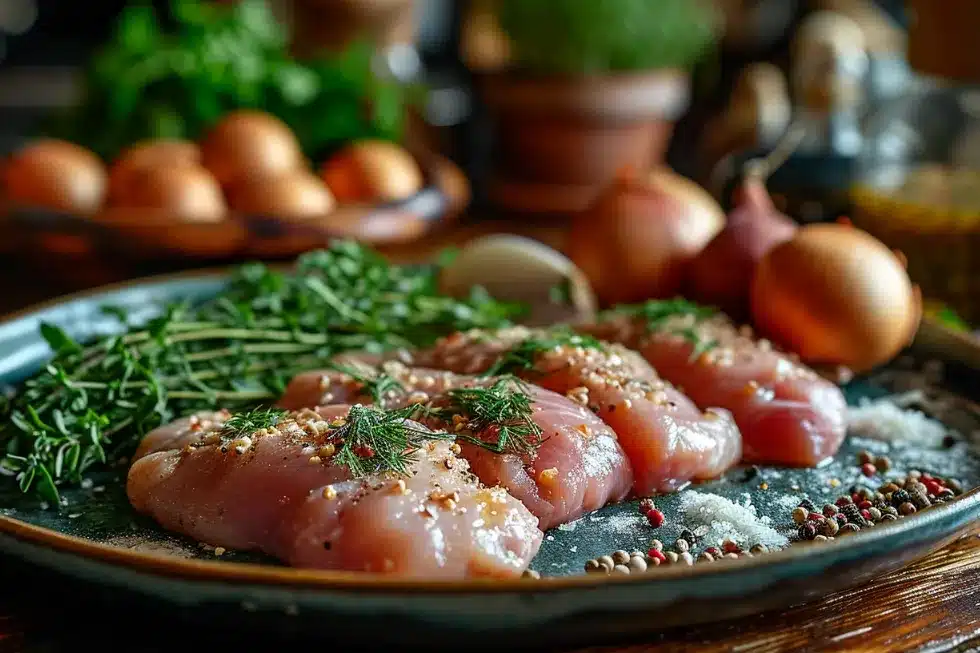
Recipe Preparation and Ingredients
This wholesome dish combines the flavors and health benefits of its components into a satisfying meal. Here’s what you’ll need and how to prepare it:
Ingredients:
- 4 boneless, skinless chicken breasts
- 1 cup wild rice
- 2 medium onions, finely chopped
- 2 tablespoons fresh tarragon, chopped (or 1 tablespoon dried tarragon)
- 2 tablespoons olive oil
- Salt and pepper to taste
- 2 cups low-sodium chicken broth or water
Preparation Steps:
- Preheat the Oven: Start by preheating your oven to 375°F (190°C).
- Prepare the Rice: Rinse the wild rice under cold water. In a medium saucepan, combine the rice with chicken broth or water. Bring to a boil, then reduce heat, cover, and simmer for about 45 minutes, or until the grains are tender and have burst open.
- Season the Chicken: While the rice is cooking, season the chicken breasts with salt, pepper, and half of the chopped tarragon.
- Cook the Onions: In a skillet, heat the olive oil over medium heat. Add the chopped onions and sauté until they are translucent and slightly golden.
- Bake the Chicken: Place the seasoned chicken breasts in a baking dish. Spread the cooked onions over the chicken. Bake in the preheated oven for 25-30 minutes, or until the chicken is cooked through.
- Combine and Serve: Once the chicken and rice are both cooked, mix the wild rice with the remaining tarragon. Serve the chicken on a bed of flavored wild rice.
This dish not only caters to the nutritional needs of those managing diabetes but also provides a delightful dining experience with its combination of flavors and textures.
Cooking Process
The cooking process for this dish is straightforward, yet it’s important to follow the steps carefully to ensure the best flavors and nutritional benefits:
- Cooking the Wild Rice: Start by cooking the wild rice as it takes the longest. Simmering it slowly in low-sodium broth or water enhances its flavor without adding excess sodium.
- Baking the Chicken: Season the chicken breasts with tarragon, salt, and pepper. Baking the chicken is a healthier option compared to frying, as it reduces the need for additional fats while retaining the meat’s moisture and flavor.
- Sautéing Onions: Sauté the onions until golden. This caramelization process brings out their natural sweetness, adding a depth of flavor to the dish without the need for added sugars.
- Combining Ingredients: After baking, the chicken is juicy and infused with the flavors of tarragon and onions. Combining it with the cooked wild rice creates a harmonious blend of textures and tastes.
- Garnishing: A final sprinkle of fresh tarragon before serving not only adds a burst of flavor but also enhances the visual appeal of the dish.
- Cooking Tips: Ensure the chicken is cooked through (internal temperature of 165°F or 75°C) for safety. Let the chicken rest for a few minutes after baking for juicier meat.
This meal is not only diabetic-friendly but also a delightful culinary experience, proving that healthy eating can be both delicious and satisfying.

Serving Suggestions
Serving this dish in a way that complements a diabetic diet is just as important as its preparation. Here are some suggestions to make the most out of this nutritious meal:
- Portion Control: Serve appropriate portion sizes to manage carbohydrate intake effectively. A balanced plate might include a quarter plate of wild rice, a quarter plate of chicken, and half a plate of non-starchy vegetables.
- Pairing with Vegetables: Enhance the meal with a side of non-starchy vegetables such as steamed broccoli, green beans, or a fresh salad. These add fiber and nutrients without significantly increasing the carbohydrate content.
- Healthy Fats Addition: Incorporate a small serving of healthy fats, like a drizzle of olive oil, over the vegetables, to add flavor and promote satiety.
- Herb Infusion: Garnish with additional fresh herbs, not just for flavor but also for their potential health benefits. Herbs like parsley or cilantro can add a fresh twist to the dish.
- Balancing the Meal: If including a starter or dessert, choose options that are low in carbohydrates and sugars. A light soup or a fruit-based dessert can be a good choice.
- Mindful Eating: Encourage slow and mindful eating to aid digestion and enhance satisfaction with the meal.
These serving suggestions aim to maintain the dish’s nutritional balance, making it a wholesome addition to a diabetic-friendly diet.
Nutritional Information
Providing the nutritional breakdown of this dish is essential for individuals managing diabetes, as it helps in making informed decisions about portion sizes and insulin adjustments.
- Carbohydrate Content: Detailing the total carbohydrates per serving, including the amount of dietary fiber, which is crucial for blood sugar management.
- Protein and Fats: Listing the amount of protein and fats in the dish, which play a role in satiety and have a lesser impact on blood sugar levels compared to carbohydrates.
- Caloric Information: Providing the total calories per serving helps in maintaining energy balance and weight management, which are important aspects of diabetes care.
- Micronutrients: Highlighting key vitamins and minerals present in the dish, like vitamin B from chicken, magnesium from wild rice, and antioxidants from onions and tarragon.
- Low Glycemic Index: Emphasizing that the dish has a low to moderate glycemic index, making it suitable for steady blood sugar control.
- Portion Recommendations: Offering guidance on portion sizes in relation to daily carbohydrate and calorie goals for individuals with diabetes.
This nutritional information ensures that the dish can be effectively incorporated into a diabetic meal plan, aligning with individual health goals and dietary needs.
The Diabetes diet is a carefully crafted nutritional plan designed to help manage blood sugar levels effectively. By emphasizing complex carbohydrates, fiber-rich foods, and portion control, this diet empowers individuals with diabetes to maintain stable glucose levels and reduce the risk of complications. It's not just a dietary choice; it's a powerful tool for better health and improved quality of life.
Conclusion: Enhancing Diabetes Management through Nutritious Cooking
The recipe for baked chicken and wild rice with onion and tarragon exemplifies how diabetic-friendly meals can be both nutritious and full of flavor. This dish not only satisfies the palate but also aligns with the dietary needs essential for managing diabetes. By choosing ingredients that are low in carbohydrates, high in fiber, and rich in essential nutrients, you can enjoy delicious meals without compromising blood sugar control.
Embracing recipes like this one is a testament to the fact that a diabetic diet doesn’t have to be restrictive or bland. It opens up a world of culinary possibilities where health and taste go hand in hand. Cooking at home with fresh, whole ingredients gives you control over what you eat and allows you to take an active role in your diabetes management.
We hope this recipe inspires you to explore more diabetic-friendly cooking options and discover that balancing your blood sugar can be a delightful and rewarding experience.

